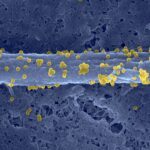Lien vers Pubmed [PMID] – 29755432
Front Microbiol 2018;9:789
Endogenous retroviruses are remnants of retroviral infections. In contrast to their human counterparts, murine endogenous retroviruses (mERV) still can synthesize infectious particles and retrotranspose. Xenotransplanted human cells have occasionally been described to be mERV infected. With genetic engineered mice and patient-derived xenografts (PDXs) on the rise as eminent research tools, we here systematically investigated, if different tumor models harbor mERV infections. Relevant mERV candidates were first preselected by next generation sequencing (NGS) analysis of spontaneous lymphomas triggered by colorectal cancer (CRC) PDX tissue. Two primer systems were designed for each of these candidates (AblMLV, EcoMLV, EndoPP, MLV, and preXMRV) and implemented in an quantitative real-time (RT-qPCR) screen using murine tissues ( = 11), PDX-tissues ( = 22), PDX-derived cell lines ( = 13), and patient-derived tumor cell lines ( = 14). The expression levels of mERV varied largely both in the PDX samples and in the mouse tissues. No mERV signal was, however, obtained from cDNA or genomic DNA of CRC cell lines. Expression of EcoMLV was higher in PDX than in murine tissues; for EndoPP it was the opposite. These two were thus further investigated in 40 additional PDX. In addition, four patient-derived cell lines free of any mERV expression were subcutaneously injected into immunodeficient mice. Outgrowing cell-derived xenografts barely expressed EndoPP. In contrast, the expression of EcoMLV was even higher than in surrounding mouse tissues. This expression gradually vanished within few passages of re-cultivated cells. In summary, these results strongly imply that: (i) PDX and murine tissues in general are likely to be contaminated by mERV, (ii) mERV are expressed transiently and at low level in fresh PDX-derived cell cultures, and (iii) mERV integration into the genome of human cells is unlikely or at least a very rare event. Thus, mERVs are stowaways present in murine cells, in PDX tissues and early thereof-derived cell cultures. We conclude that further analysis is needed concerning their impact on results obtained from studies performed with PDX but also with murine tumor models.

